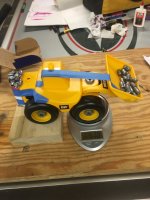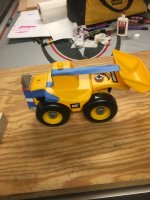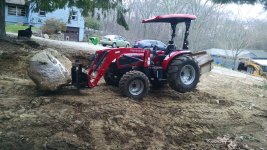You are using an out of date browser. It may not display this or other websites correctly.
You should upgrade or use an alternative browser.
You should upgrade or use an alternative browser.
Ballast weight - how high can I go?
- Thread starter Fastball
- Start date
- Views: 20388
More options
Who Replied?
/ Ballast weight - how high can I go?
#61
ovrszd
Epic Contributor
- Joined
- May 27, 2006
- Messages
- 33,724
- Location
- Missouri
- Tractor
- Kubota M9540, Ford 3910FWD, Ford 555A, JD2210
I run 2000 pounds on the back of my machine - tires not loaded. Sometimes it's not quite enough.
A great example of how ballast adds weight/stress on the front axle rather than reduce it.
jb1390
Gold Member
A great example of how ballast adds weight/stress on the front axle rather than reduce it.
In this case, yes. Under normal lifting requirements, no. You can get into all kinds of speculative discussions about whether axle failures are caused by one time over-loading or cyclic. This much weight benefits you for cyclic loading but hurts for one-time overloading.
But I don't run the weight to reduce stress on the front axle, I run it to make the weight and handling of the machine match its hydraulic capability. If I break something along the way, o well, I'll fix it and move on. I try to not abuse it, but I push the limits more than most.
When I had my deere 300, I ran 3k pounds of counterweight. Since it was only 2wd, it needed a bit extra. The hydraulics would just barely lift that block. I never ran into any issues running that weight.
4570Man
Super Star Member
- Joined
- Apr 7, 2015
- Messages
- 18,888
- Location
- Crossville, TN
- Tractor
- Kubota M59, Kubota L3800, Grasshopper 428D, Topkick dump truck, 3500 dump truck, 10 ton trailer, more lighter trailers.
Here's a quick experiment using a toy loader with a cardboard box strapped on the back to represent a ballast box on the back. I attempted to use a rubber band to represent hydraulic strength but that didn't work and I had to just measure tipping load. The weight of my toy loader was 500 grams. The fairly proportional ballast weight was 158 grams. I zeroed the scale with the front axel on it and added weight until the loader tipped. The front axel weight was 417 grams when it tipped with no ballast. I added the 158 grams of ballast and this time the front axel weighed 850 grams when it tipped. Then I added more ballast in an attempt to reduce the front axle weight to where we started. I was unable to do that before my ballast box filled up, but at that point the ballast already weighed a completely un proportional 750 grains. I was only able to reduce the previous axel weight to 570 grams with the extreme amount of ballast. 



LD1
Epic Contributor
I have said it in many many other threads that ballast BEHIND the rear axle INCREASES the load on the front axle....but only up to the point that the rears remain planted terra-firma.
From THAT point forward......any additional amount added BEHIND the axle is INDEED reducing front axle load.
How much so depends on just what the ballast is (how far back) and what the wheelbase of the tractor is.
If the wheel base is 6'....and your load behind the rear axle is 2' back......thats 3:1.....meaning ever additional 3# of counterweight reduces front load by only 1#.
Longer is better for the "counter weight" effect....but sometimes not the best because alot pf people choose a counterweight because of short compact package to maneuver in tight areas.
Thats why any time these "how much ballast do I need " threads come up...I cringe at some of the low numbers people are suggesting. Because its clear they have no regard for lightening front axle load and only worry about stability. The numbers I suggest are often double what others suggest.
I'll use my old L3400 for example.
Bare tractor + loader is ~3800#. FEL is capable of ~2000# ground level. But absent any ballast.....could only muster 700# ground level before rears would hike up in the air. So that 700# lift + 3800# tractor and loader was putting 4500# on the front axle.
Loaded the rears and added 400#.....so bare tractor now weights 4200# with loader. That increased my lift capacity up front to 1200# before rears lifted. I now have 5400# on the front axle. A 900# increase vs no ballast at all.......just by simply filling the rears (which is so highly recommended on here for loader work)
I hang a 700# rear blade off the back centered 5' behind the rear axle. Now I weigh 4900# and can fully max out my front loader lift of #2000....but just barley. FOr all intents and purposes.....ALL the weight is on the front.....4900+2000 = 6900# on my fronts.
Now as i said....from this point forward....more weight or weight further back reduces that load.
I hang my 1100# bushhog......with COG a good foot or two further back than the 700# blade. My total machine weight is now 5300#....can can still max out my 2000# lift. But an additional #400 more than the blade......and hanging further back......rather than having 0 weight on the rear tires.....I can maintain 1000# on the rears. So 5300# machine + 2000# load - 1000# kept on the rears......front load is 6300#. Which is LESS than with the inadequate amount of weight that the blade provided.
So yea....its not just about having ballast for stability. Its about having ENOUGH ballast to be effective.
Many thread about guys with similar sized L3400's and people saying 600-700# is enough.....NO ITS NOT.
And many threads of people with similar machines to my MX5100, saying 900-1000# (in the form of a close compact box) is enough. NO ITS NOT. I have a 1620# woods DS96 that has a COG a good 4' behind the lift eyes of the 3PH. It keeps me planted but more would sure be better for the front axle.
From THAT point forward......any additional amount added BEHIND the axle is INDEED reducing front axle load.
How much so depends on just what the ballast is (how far back) and what the wheelbase of the tractor is.
If the wheel base is 6'....and your load behind the rear axle is 2' back......thats 3:1.....meaning ever additional 3# of counterweight reduces front load by only 1#.
Longer is better for the "counter weight" effect....but sometimes not the best because alot pf people choose a counterweight because of short compact package to maneuver in tight areas.
Thats why any time these "how much ballast do I need " threads come up...I cringe at some of the low numbers people are suggesting. Because its clear they have no regard for lightening front axle load and only worry about stability. The numbers I suggest are often double what others suggest.
I'll use my old L3400 for example.
Bare tractor + loader is ~3800#. FEL is capable of ~2000# ground level. But absent any ballast.....could only muster 700# ground level before rears would hike up in the air. So that 700# lift + 3800# tractor and loader was putting 4500# on the front axle.
Loaded the rears and added 400#.....so bare tractor now weights 4200# with loader. That increased my lift capacity up front to 1200# before rears lifted. I now have 5400# on the front axle. A 900# increase vs no ballast at all.......just by simply filling the rears (which is so highly recommended on here for loader work)
I hang a 700# rear blade off the back centered 5' behind the rear axle. Now I weigh 4900# and can fully max out my front loader lift of #2000....but just barley. FOr all intents and purposes.....ALL the weight is on the front.....4900+2000 = 6900# on my fronts.
Now as i said....from this point forward....more weight or weight further back reduces that load.
I hang my 1100# bushhog......with COG a good foot or two further back than the 700# blade. My total machine weight is now 5300#....can can still max out my 2000# lift. But an additional #400 more than the blade......and hanging further back......rather than having 0 weight on the rear tires.....I can maintain 1000# on the rears. So 5300# machine + 2000# load - 1000# kept on the rears......front load is 6300#. Which is LESS than with the inadequate amount of weight that the blade provided.
So yea....its not just about having ballast for stability. Its about having ENOUGH ballast to be effective.
Many thread about guys with similar sized L3400's and people saying 600-700# is enough.....NO ITS NOT.
And many threads of people with similar machines to my MX5100, saying 900-1000# (in the form of a close compact box) is enough. NO ITS NOT. I have a 1620# woods DS96 that has a COG a good 4' behind the lift eyes of the 3PH. It keeps me planted but more would sure be better for the front axle.
2ndhalf
Veteran Member
This makes sense even to me, thanks for taking the time to explain in great detai LD1.
pmsmechanic
Elite Member
- Joined
- Dec 6, 2013
- Messages
- 4,364
- Location
- Southern Alberta, Canada
- Tractor
- 4410 and F-935 John Deere, MF 245
LD1 I understand your reasoning on weight behind the rear wheels and what you are saying makes sense.
So are you saying that CUT front axles aren't designed for those types of loads? If so then to me that seems to be a short coming on the manufactures part.
I might not be able to respond to this post for a few weeks. I'll try to remember to come back to it.
So are you saying that CUT front axles aren't designed for those types of loads? If so then to me that seems to be a short coming on the manufactures part.
I might not be able to respond to this post for a few weeks. I'll try to remember to come back to it.
LD1
Epic Contributor
I don't really think it's a matter of "not designed for the weight"
I think it's simply a matter of the more heavily you load it, and the more often.....the sooner it wears things out. Gears, bearings, seals, tires, etc.
The rear axle, wheels, bearings, etc are much more massive. Can take the load alot better.
I think it's simply a matter of the more heavily you load it, and the more often.....the sooner it wears things out. Gears, bearings, seals, tires, etc.
The rear axle, wheels, bearings, etc are much more massive. Can take the load alot better.
Oldoak
Veteran Member
- Joined
- Feb 20, 2013
- Messages
- 1,817
- Tractor
- Kubota L5060GST, J D X758 GT, J D 855D XUV
I believe that statement makes more sense than anything else.I don't really think it's a matter of "not designed for the weight"
I think it's simply a matter of the more heavily you load it, and the more often.....the sooner it wears things out. Gears, bearings, seals, tires, etc.
The rear axle, wheels, bearings, etc are much more massive. Can take the load alot better.
It's all about using the right tools or machinery for the job. Compact tractors and sub compacts are not designed to do the work of skid steers or HD farm tractors and industrial machines. They can be operated and pushed to the limits, but the quicker things wear out or break.
Too often I see "look what I can do with my tractor" or similar. Well, yes you can, but how long can you keep that up before something gives out?

